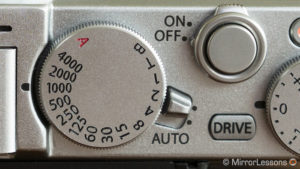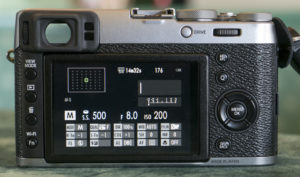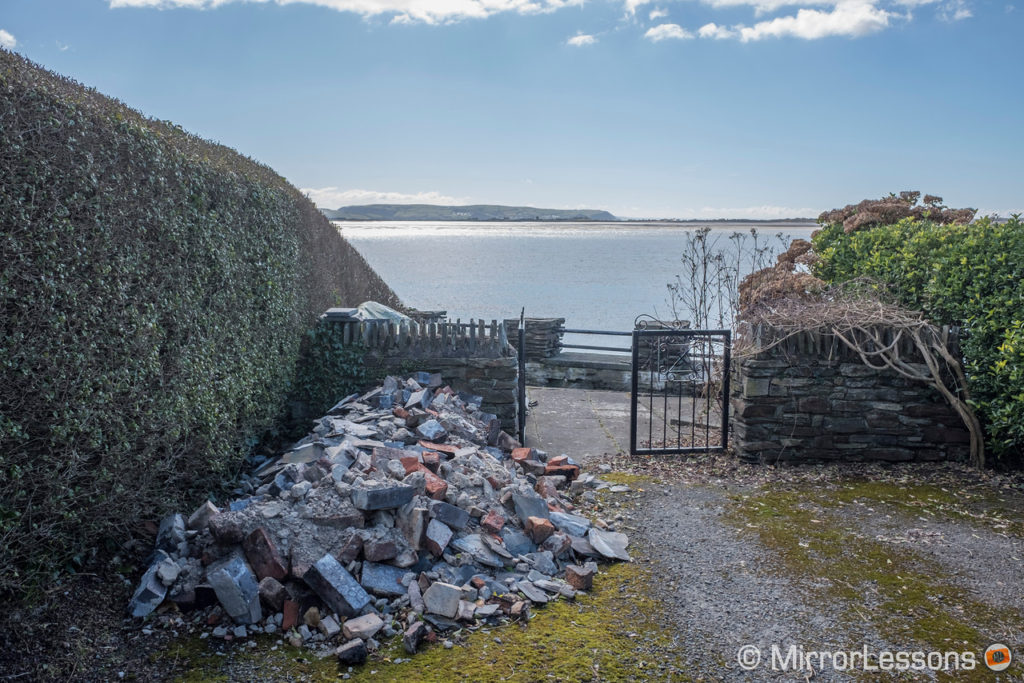In many ways, the Fujifilm X70 and X100T are cut from the same cloth. In addition to both being premium fixed-lens compacts from Fujifilm, they also incorporate the same 16MP APS-C X-Trans II CMOS sensor and feature a very similar design.
You may be wondering: are there enough differences to merit a comparison? Even though the image quality is the basically identical, I would say that there are.
The most salient differences are the field of view and optical quality of their respective fixed lenses, followed by the small gap between their autofocus systems. The remaining differences mostly regard the body, such as the size and weight, viewfinder (or lack thereof) and LCD screen.
Still want to learn more? Then let’s take a more in-depth look!
Ethics statement: The X70 and X100T are part of our personal collection. We were not asked to write anything about the lenses, nor were we provided with any sort of compensation. Within the article, there are affiliate links. If you buy something after clicking the link, we will receive a small commission. To know more about our ethics, you can visit our full disclosure page. Thank you!
[toc heading_levels=”2″]
Design, Ergonomics and Ease of Use
The first thing you’ll notice about the X70 and X100T is that the former is smaller and lighter than the latter.
The X70 weighs 340g with the battery and memory card and measures 112.5 x 64.4 x 44.4mm, making it the more pocketable of the two. The X100T weighs 440g with the battery and memory card and measures 127 x 74 x 52 mm. Although it is larger than the X70, it is still quite compact.
Neither is weather sealed but the X100T has the better build quality thanks to its magnesium-alloy chassis. In fact, we once dropped the X100T on concrete and it survived the fall with just a small scratch to show for it! The X70 has a plastic and aluminium body, so it is certainly less robust.
Between the two cameras, the X70 has the better grip which is surprising as the X100T, being larger and heavier, would benefit from one.
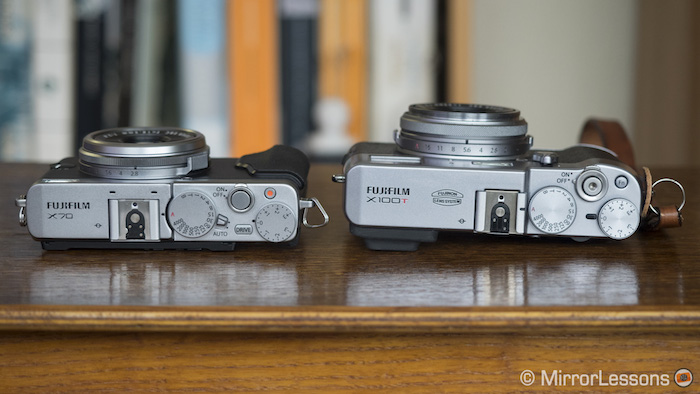
The X70 has a small textured grip on the front and a thumb rest on the rear. It is very comfortable to hold even for long periods of shooting. The X100T is textured all over and is slightly chunkier on the right. Since it lacks a proper grip, we find that it benefits from an additional thumb rest like the one from Lensmate. (You can find it on Amazon.)
Both the X70 and X100T feature a traditional design that harks back to the era of analog cameras. You can purchase the cameras in either black or a combination of black and silver. They feature a plethora of dials on the body, including a shutter speed dial and exposure compensation dial on the top plate, and an aperture ring around the lens. Anyone who has used a film camera will soon find themselves at home with the positioning of the dials around the body.
The shutter button is found on top and is surrounded by an on/off switch.
The X100T’s shutter button is threaded, so you can easily screw on a soft button like the one we own from Lensmate. The X70’s shutter button isn’t threaded, so if you want to use a soft button, you need to buy one with an adhesive such as the Lolumina soft button.
Both cameras have seven customisable buttons around the body but they are found in slightly different positions. For example, the dedicated function button found on the X100T’s top plate has been replaced by a movie record button on the X70 which is also customisable.
On the X70, nearly all the buttons on the rear have been placed on the right-hand side for easy one handed access. Two exceptions are the Delete and Playback buttons which are now located at the top of the tilting screen. The X100T has buttons on the right and left, making it more difficult to use with one hand. The designers probably could have optimised the space on the right a little better.
The Drive button is located on the rear of the X100T, while on the X70, it has been enlarged and moved to the top plate. This was a good choice, as it is easier to access.
However, the S-AF/C-AF/MF focusing switch is easier to use on the X100T because it isn’t as stiff. It is located on the side of the X100T while on the X70, it has been moved to the front.
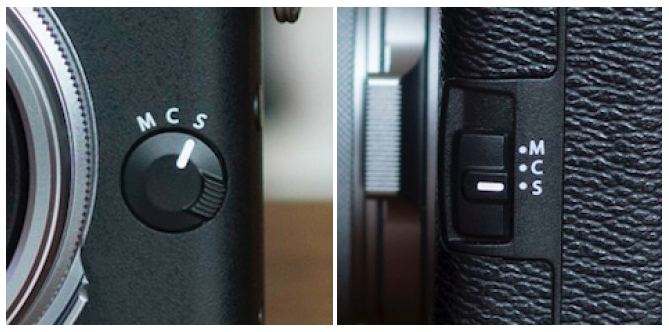
Both cameras feature a four-way control pad that you can either use to set the focus point or customise with your preferred functions. There is a hot shoe on top, and everyone’s favourite customisable Q (Quick) button on the rear for access to all the most important settings.
To adjust the shutter speed when in shutter speed priority or full manual mode, there is also a black dial on the rear of the two cameras. It can also be used to scroll through menus.
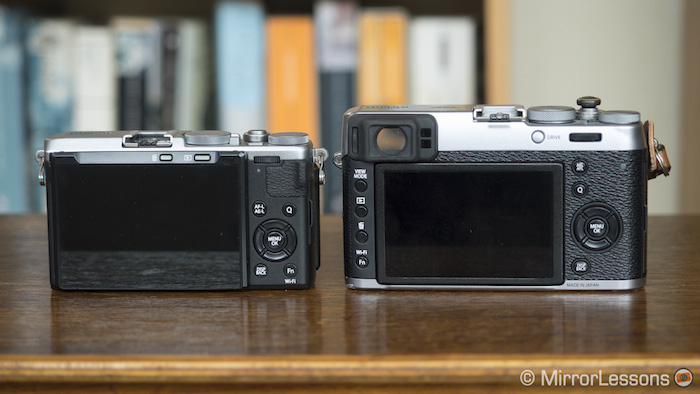
The one on the X70 is smaller, does not turn and has a raised bump in the centre, making it more like a toggle than a dial. By pressing it, you can magnify your image while shooting in S-AF or MF mode. The one on the X100T is larger and turns like a regular dial. It is nicer to use than the one on the X70 because of its size but can only be pressed to magnify your image in MF mode.
Now we come to one of the biggest differences between the two cameras: the viewfinder and LCD screen.
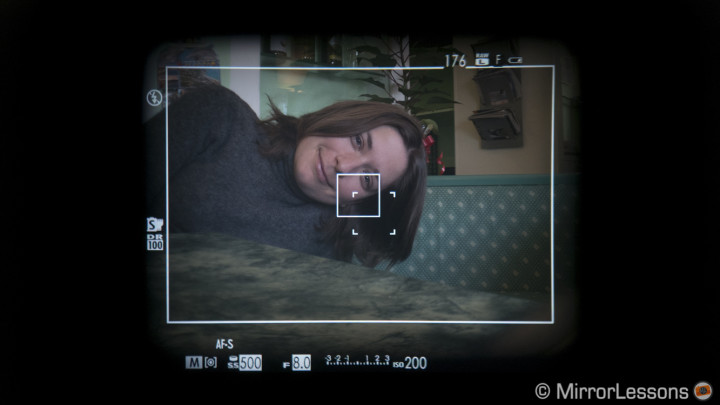
The X100T has a built-in hybrid viewfinderpositioned on the left. It is called hybrid because you can switch between an optical and electronic viewfinder. It is one of the key selling points of the camera. With the electronic viewfinder, you can see your exposure and picture effects in real time. There are several MF assists including Digital Spilt Image, a digital version of the rangefinder mechanism. If you switch to the optical viewfinder, you can benefit from a real-time parallax correction and activate the ERF (Electronic Rangefinder) that shows you a digital magnified portion of your frame in the bottom right-hand corner.
The X70 lacks an electronic viewfinder. In a way, it is a shame as there are many compacts out there such as the Lumix LX100 or the RX100 III/IV that, despite being as small or even smaller than the X70, have a built-in EVF. Perhaps the choice to exclude it was Fujifilm’s way of keeping the cost down. (Note that there is an optional optical viewfinder for the X70 (VF-X70) that can be mounted on the hot-shoe.)
However, the X70 does have a trick up its sleeve. It is the first Fujifilm camera to feature a tilting touch sensitive LCD screen.
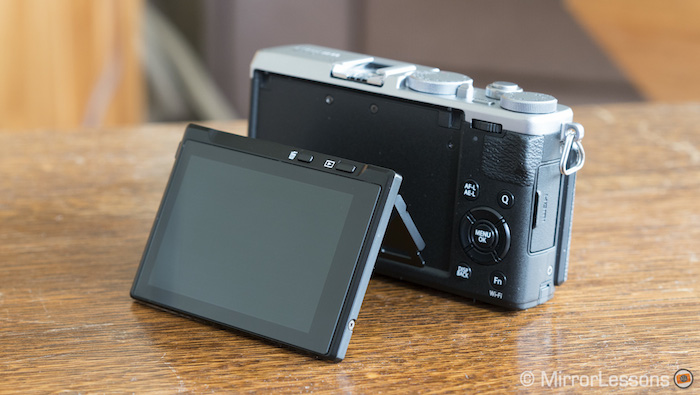
Other X series cameras have a tilting screen but none are as versatile as the X70’s. It can tilt down 45 degrees and up 180 degrees, and activates a selfie mode (face/eye detection) when flipped up all the way. This makes it very useful for shooting at awkward angles.
The touch capabilities are unique to this model, although cameras from other brands such as Olympus and Lumix have had touch capabilities for ages. You can select an AF point, take a picture or deactivate touch sensitivity.
Sadly, the X100T has neither a tilting screen nor touch capabilities. I sincerely hope that Fujifilm decides to give these functions to future X100 models because they are very useful for street photography.
Moving on to the lens, both cameras feature a flat pancake-style lens that is fixed to the body.
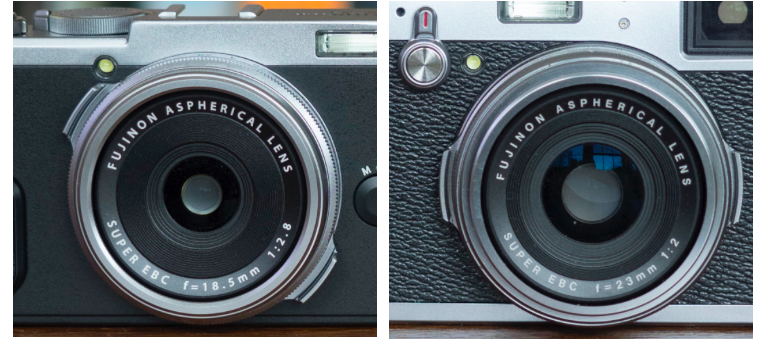
The X70 has a focal length of 18.5mm which works out to be about a 28mm field of view in 35mm format terms while the X100T has a focal length of 23mm which is the equivalent of 35mm in 35mm format.
The filter thread of the two lenses is 49mm. If you own the X100 LEE ND filter adapter, it will also fit the X70.
Both are surrounded by a textured focus ring and an aperture ring that turns in clicks. The aperture range goes from f/2.8 to f/16 on the X70 while the X100T has an additional aperture value of f/2. Both include an A (automatic) option.
I personally find the focus ring somewhat tricky to rotate on the X70 because the two tabs on the aperture ring obstruct your fingers. The same tabs on the X100T’s aperture ring are spaced a little further from the focus ring, so it is easier to turn.
Note that the focus ring on the X70 doubles up as a control ring to which you can assign a variety of settings such as ISO, white balance, film simulation modes, digital teleconverter and more. This isn’t possible on the X100T.
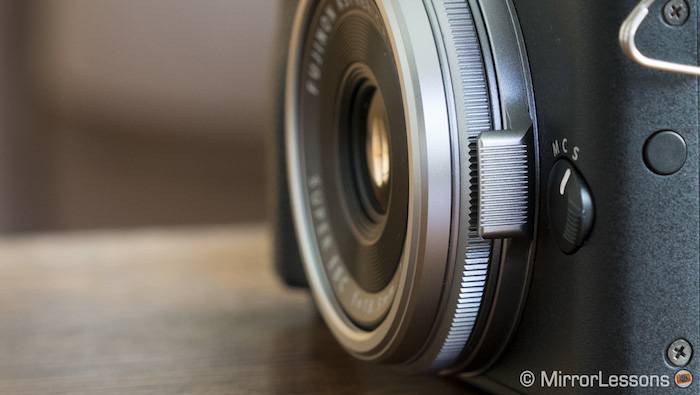
Both cameras have a built-in flash with +-2EV of compensation. Thanks to the leaf shutter mechanism, both can sync up to 1/4000s.
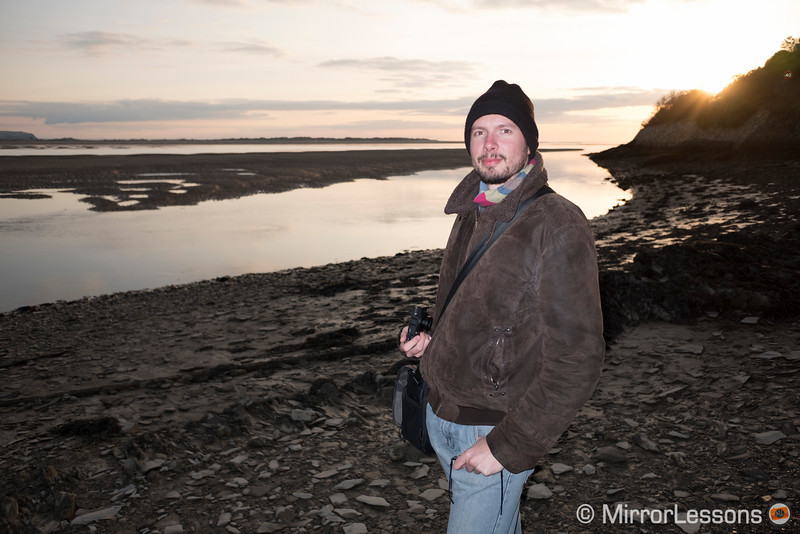
The battery life is decent on both cameras, though you can extend it by putting the cameras into Low performance mode and putting the OVF into power saving mode on the X100T. I’ve found that one battery on either camera will last about a half a day of intensive shooting or a day of light shooting.
Image Quality: The sensor


The image quality section of this comparison is the easiest to write because there isn’t really anything to compare. The differences you’ll find are due to the lenses which we’ll discuss in the following section.
Both cameras feature the same 16MP APS-C X-Trans II CMOS sensor and EXR II processor found inside the other X series models including the X-T1, X-T10 and X-E2. X-Trans differs from the traditional Bayer type sensor in that it uses an irregular pattern of pixels to reduce moire without the need for an anti-aliasing filter. The irregular pattern ensures that every horizontal and vertical line has at least one R, B and G pixel.

In our experience with Fujifilm cameras, the image quality from the X-Trans sensor is up there amongst the best.
The colours have a very natural and organic look thanks to Fujifilm’s colour profiles (called Film Simulation Modes). Our favourite profiles include the latest colour profile, Classic Chrome, which is interesting for reportage and documentary photography because it doesn’t overly saturate the colours and maintains an excellent level of contrast, Astia for its pleasant contrast and subtle palette, and the various B&W profiles.


The dynamic range is also very good. Since you can shoot 14-bit uncompressed RAW, it is possible to recover most of the details in the highlights and shadows without encountering colour cast or excessive noise. If you shoot JPGs, you have the option of increasing or decreasing the shadows and highlights in the Q menu. There is also the DR option that will retain the same dynamic range when using ISO speeds higher than 200.
Below is an example showing 100% shadow and highlight recovery of an image taken with the X70.

A good example of how well the D-Range optimiser (set to 400) can work at 800 ISO.
Moving on to the low-light performance, both cameras provide a native ISO range of 200-6400 with 100, 12800, 25600 and 51200 pull values. I find that you can comfortably use values as high as 6400, though I prefer to stay at 3200 and below if possible.

X70, 1/170, f/2.8, ISO 1600


Beyond 6400, you begin to encounter excessive noise and a noticeable loss in detail. What’s more, you can only shoot JPGs, so there is little scope to edit the files in post-production. A handy feature are the three options for Auto-ISO with which you can set the default sensitivity, maximum sensitivity and minimum shutter speed.


As for sharpness and detail, you can achieve very good results thanks to the 16MP of the sensor and the optical quality of the lenses. However, you may have inconsistent results from the RAW files depending on the software you use. Lightroom and Adobe Camera RAW are known for their limited ability to develop Fujifilm RAF files especially in the case of foliage. It is nothing to panic about because we use Lightroom all the time but for specific photos you might want to look into an alternative software such as Iridient Developer.

Image Quality: The lens
Here we arrive at yet another significant point that sets the two cameras apart: the fixed lenses!
As mentioned in the design section, X70 has a fixed 18.5mm lens. With the APS-C sensor, it gives you a 28mm field of view which is perfect for a variety of genres including street, landscape, architecture and even environmental portraits. It constitutes 7 elements in 5 groups with 2 aspherical glass moulded lens included. The aperture range is f/2.8 to f/16.
The X100T has the classic 35mm field of view, which becomes 23mm in APS-C format. It is a great focal length for street and environmental portraits. It constitutes 8 lenses in 6 groups with (1 aspherical glass molded lens included). The aperture range is f/2 to f/16.
Owing to its slightly faster aperture of f/2 and narrower field of view, you can achieve a better bokeh with the X100T. Both cameras have a minimum focus distance of 10cm.
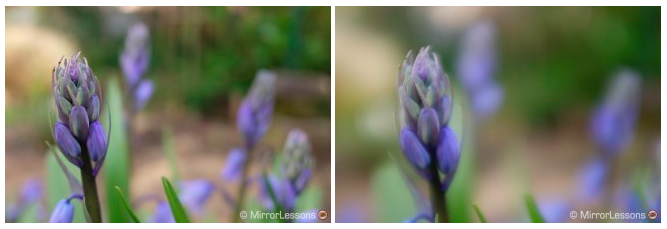


I performed an experiment to see if there was a difference in sharpness first at 10cm and then at a further distance, and the results were quite surprising.
At 10cm (the minimum focus distance), the X70’s lens produced sharper results from f/2.8 to f/4 with better overall contrast. The results start to bear a much closer resemblance at f/5.6 and beyond.
The X100T at f/2 in particular is very soft and lacks contrast compared to the rest of the aperture values. Since the X70 doesn’t have an f/2 value, we cannot conduct a direct comparison but what we can say is that the X70, at its own fastest aperture of f/2.8, is sharper than the X100T at f/2.
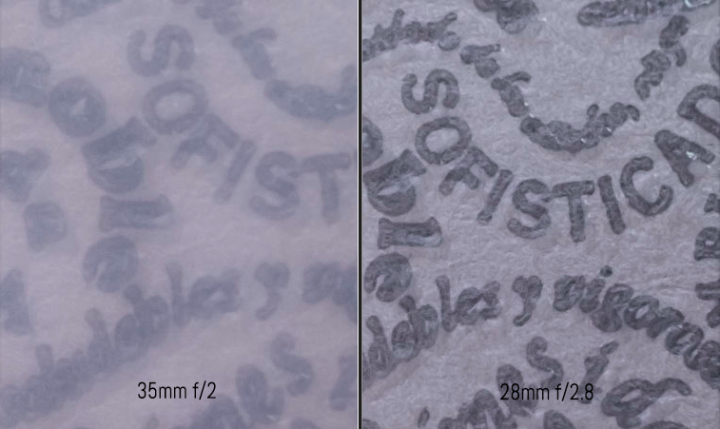
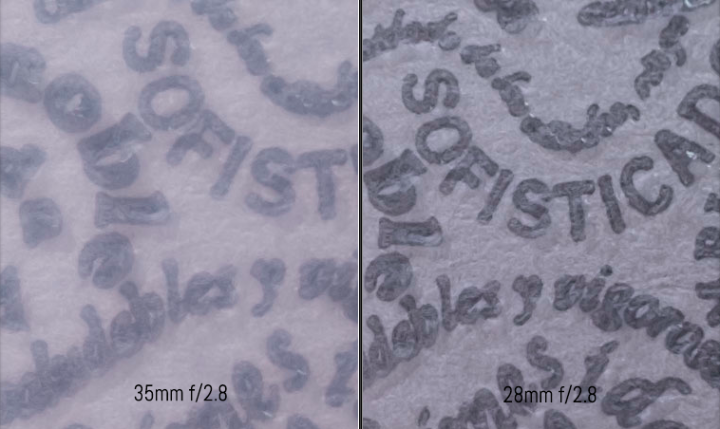
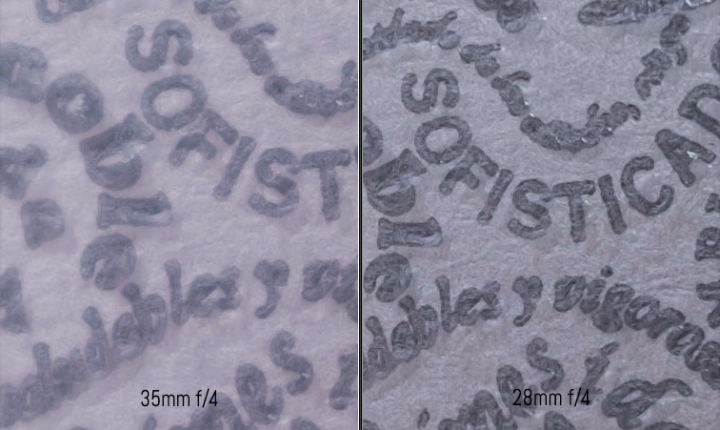
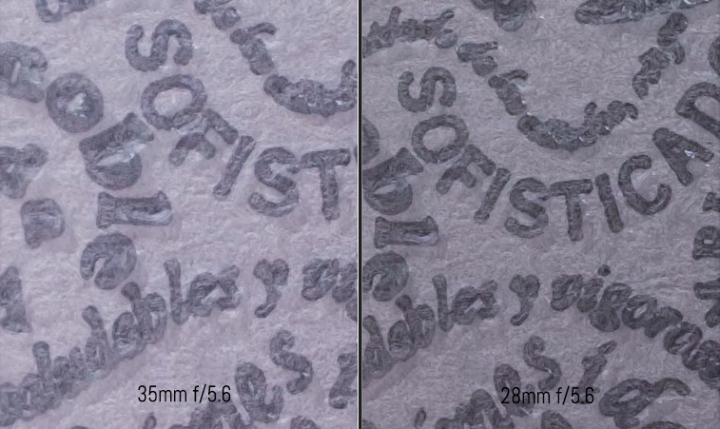
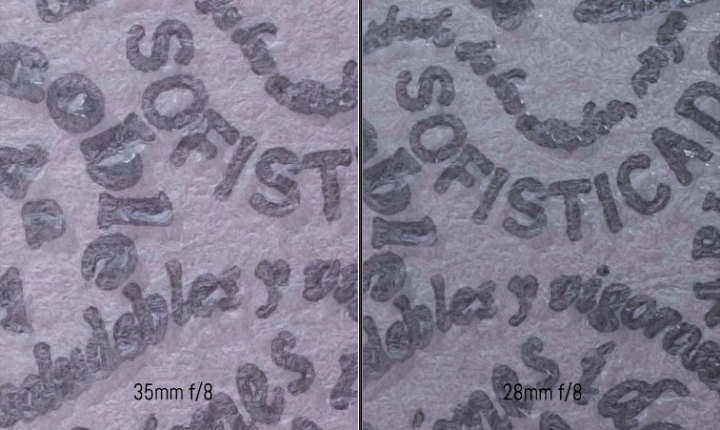
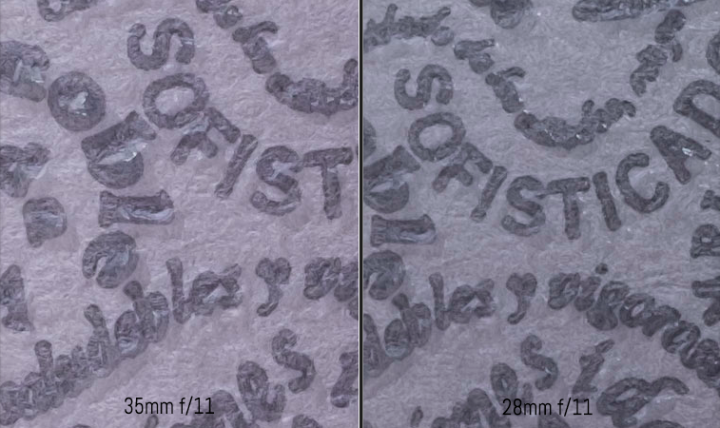
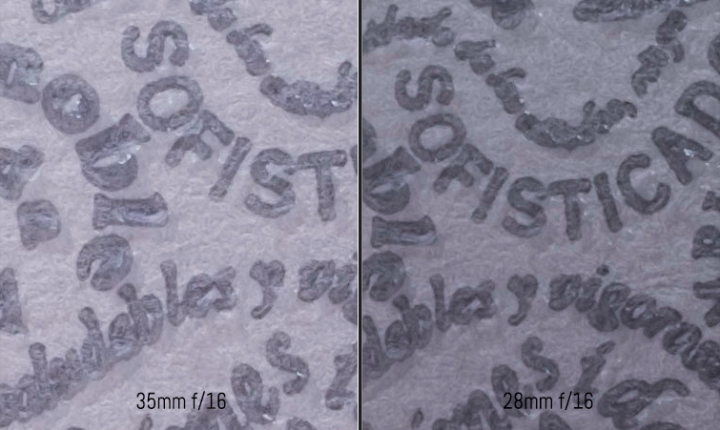
Curiously, the opposite is true when you place the cameras further from the subject (in this case, 1.5 metres away). At f/2 and f/2.8, the results are very similar from the X100T. From f/2.8 to f/4, the X100T is noticeably sharper than the X70, while from f/5.6 onward the results are similar from both cameras.
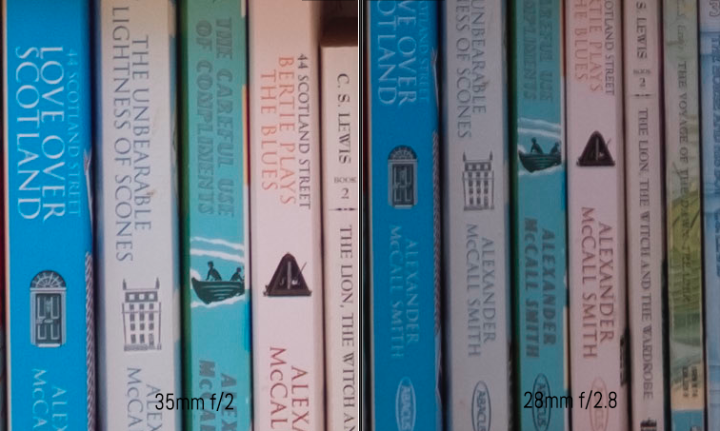
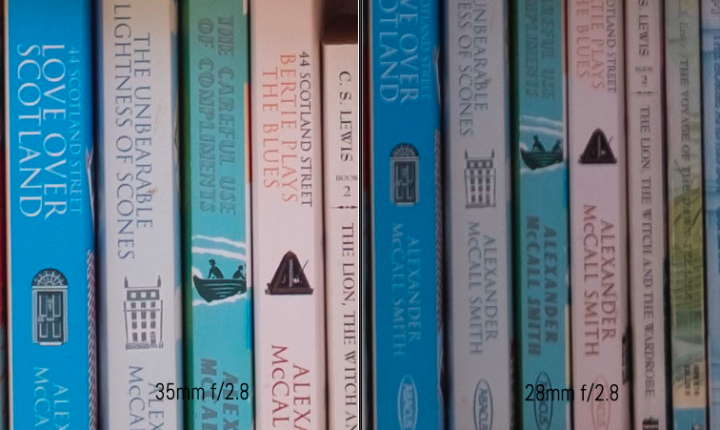

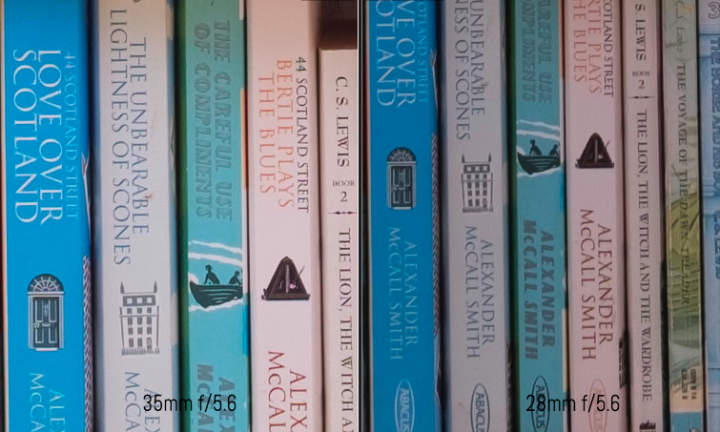
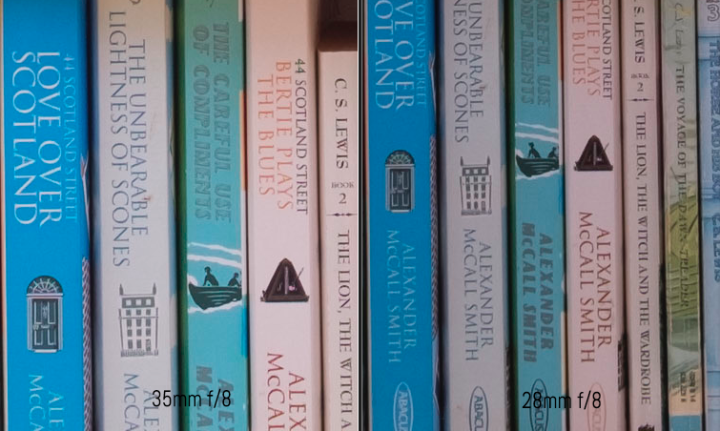
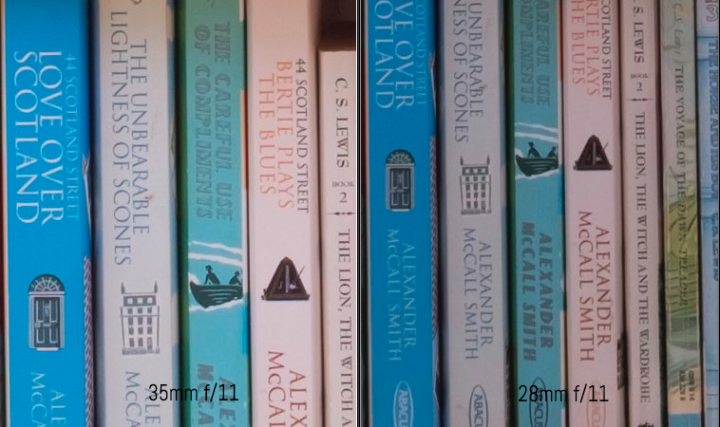
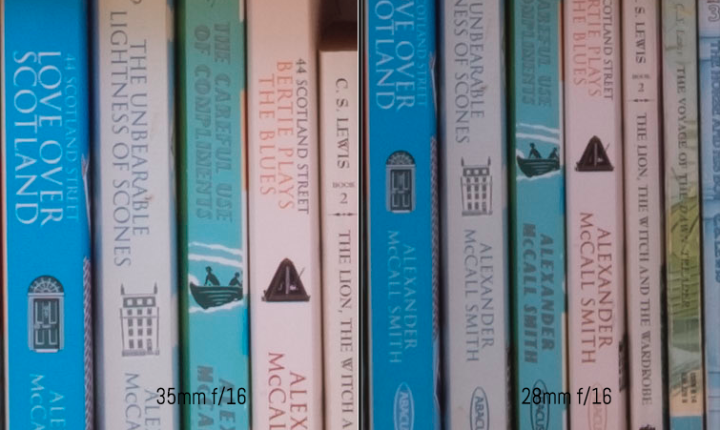
You can find a full set of high resolution images here.
Both lenses produce flare, though I found the X70’s more invasive. It is a very good idea to purchase a lens hood when you buy either camera, not only because of flare but also because it protects the lens element which is quite exposed on its own. We went for the third-party JJC lens hood (X100 version) because it costs much less than the official Fujifilm version. It fits the 49mm filter thread of both cameras.


The good news is that chromatic aberration, distortion and vignetting aren’t an issue on either camera.
Autofocus, Manual Focus and Performance
Let me state upfront that while the X70 has a more advanced autofocus system than the X100T, both perform perfectly well for street photography, the primary genre for which these cameras are likely to be used.
The X70 has the same intelligent hybrid autofocus system as the X-T1 (with firmware 4.0), X-T10 and X-E2s. Single Point still exists but Multi Area has been replaced by two new modes, Zone and Wide/Tracking, which now give you access to 77 points across the frame. Zone lets you choose 3×3, 3×5 or 5×5 AF areas to help you track moving subjects while Wide/Tracking uses all 77 points and is best for unpredictable moving subjects.
The X100T has the same autofocus system as the X-T1 without firmware 4.0. It is a hybrid autofocus system with 49 focus points (40 contrast detection and 9 phase detection) across the frame, and there are two modes: Single Point and Multi Area.
If you own an interchangeable lens Fujifilm camera like the X-T1 and long telephoto lenses like the XF 50-140mm or XF 100-400mm, you will appreciate the improvement in the AF performance but it is less of an issue for premium compacts with a fixed lens like these two, as it is unlikely you’ll be using either for sports or action.

The C-AF is good but not as good as that of the X70.

I used the X70 to take a series of shots of Mat running towards me. They were all in focus.
Of course, as is the case with most digital cameras, the AF performance decreases a little in very low light.
As for the burst capabilities and buffer, the X70 has a faster continuous shooting speed but the X100T can take more consecutive frames.
The X70 is capable of 8fps in C-AF and can take 10 JPGs in a burst. Like the X100T, if you reduce this to 3fps, you can take an unlimited number of JPGs. The X100T can shoot up to 6fps in C-AF and up to 25 JPGs in a burst. If you reduce this to 3fps, you can take an unlimited number of JPGs.
Both cameras come with the following manual focus assists: Digital Split Image (splits the centre of the screen into four stripes that you have to align to achieve focus), Magnification and Focus Peaking. Magnification is particularly useful because it can be used in conjunction with the other two assists.
Even though the manual assists on both cameras are identical, it is easier to manually focus with the X100T than the X70 for the simple reason that the focus ring is placed further away from the tabs on the aperture ring.
Both cameras feature a leaf shutter mechanism, allowing for near-silent operation and high speed sync with flash. The fastest mechanical shutter speed is 1/4000s but you can revert to the electronic shutter(which is completely silent) and use speeds as fast as 1/32000s. However, doing so will disable the use of flash.
Video
Fujifilm cameras are far better known for their still capabilities than for video, and this rule also applies to the X70 and X100T.
They can both shoot Full HD at 60fps but the footage displays some aliasing and moiré. A small yet curious difference is that while the Movie ISO on the X70 starts at 400, it begins at 200 on the X100T. Happily, it is possible to change the shutter speed, aperture and exposure compensation while you record.
Below you can see a quick video shot with the X70 at the Aberystwyth St. David’s Day parade. It should give you a good idea of the quality you can expect to see from both cameras.
Other Features
Thanks to the addition of WiFi connectivity, you can control both cameras from and upload your images to your smart device. They use same mobile app (Camera Remote) as all other Fujifilm cameras.
Within the App menu, there are four sub-menus called: Remote Control, Receive, Browse Camera and Geotagging. With remote control, you gain access to the most essential settings. You can select your AF point by tapping the screen, switch between stills/video, and play back your images once you’ve finished.
Neither camera features built-in stabilisation, so it is best to avoid critical shutter speeds if you don’t have a tripod. Since the X70 has a wider angle, it is a little easier to take in-focus shots at slow shutter speeds than with the X100T.
A nice addition to the X100T is the built-in 2 stop ND filter which is sadly lacking on the X70. By reducing the exposure by about 3EV, the filter allows you to shoot in bright conditions with a fast aperture and a slower shutter speed. Why is this important? Because when using the fastest apertures (f/2 and f/2.8) at shutter speeds at 1/1000s and above, you may observe some distortion in the bokeh rendering.

Conclusion
Small aesthetic and functional differences aside, there are two questions you should really be asking yourself if you are torn between the Fujifilm X70 and X100T:
Do I prefer the 28mm or 35mm field of view? And how much importance do I place on having a built-in viewfinder?
If you prefer a wider view of the world, the X70 is your best bet. Although there is a wide-angle converter for the X100 series, it increases the bulk of the camera to the point that you might as well just buy one of the smaller interchangeable Fujifilm cameras.
Likewise, if you feel lost without a viewfinder, the X100T will serve your purpose better than the X70. Yes, you can buy an optional optical viewfinder for the X70, but it too adds bulk to the camera and doesn’t provide the convenience of the X100T’s hybrid viewfinder.
And what if you’d rather have both a wide angle of view and a viewfinder? In that case, you may prefer to forget about both premium compacts and turn your attention to an interchangeable lens camera with an incorporated viewfinder like the X-E2.
Of course, it would be remiss of me to not mention the difference in price. Even though the X70 is the more recent model, it costs about $600 less than the X100T (brand new). You can find the X100T second-hand these days but the difference in price is still significant.
Check price of the Fujifilm X100T on
Amazon | Amazon UK | B&H Photo | eBay
Check price of the Fujifilm X70 on
Amazon | Amazon UK | B&H Photo | eBay
Second-hand Fujifilm cameras on
You may also be interested in:
Video
Below you can find our 7-minute Fujifilm X70 and X100T video comparison where we detail the five main similarities and differences between the two models.
Additional images









